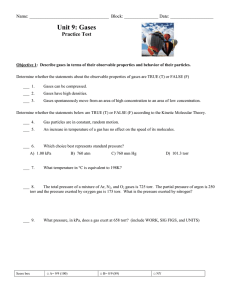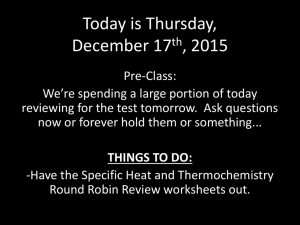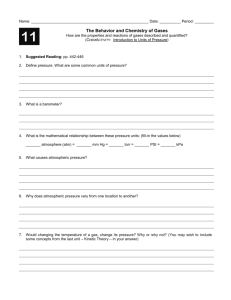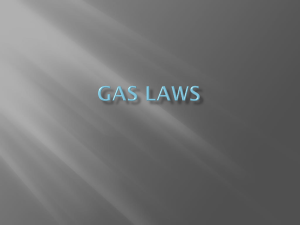I. Physical Properties of Gases
advertisement
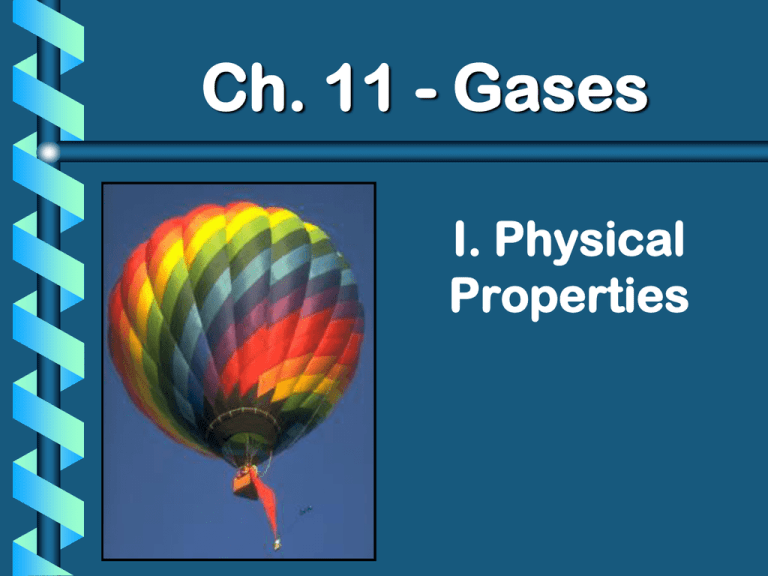
Ch. 11 - Gases I. Physical Properties A. Kinetic Molecular Theory Particles in an ideal gas… • have no volume. • have elastic collisions. • are in constant, random, straightline motion. • don’t attract or repel each other. • have an avg. KE directly related to Kelvin temperature. B. Real Gases Particles in a REAL gas… • have their own volume • attract each other Gas behavior is most ideal… • at low pressures • at high temperatures • in nonpolar atoms/molecules C. Characteristics of Gases Gases expand to fill any container. • random motion, no attraction Gases are fluids (like liquids). • no attraction Gases have very low densities. • no volume = lots of empty space C. Characteristics of Gases Gases can be compressed. • no volume = lots of empty space Gases undergo diffusion & effusion. • random motion D. Temperature Always use absolute temperature (Kelvin) when working with gases. ºF -459 ºC -273 K 0 C F 32 5 9 32 212 0 100 273 373 K = ºC + 273 E. Pressure force pressure area Which shoes create the most pressure? E. Pressure Barometer • measures atmospheric pressure Aneroid Barometer Mercury Barometer E. Pressure Manometer • measures contained gas pressure U-tube Manometer Bourdon-tube gauge E. Pressure KEY UNITS AT SEA LEVEL 101.325 kPa (kilopascal) 1 atm 760 mm Hg 760 torr 14.7 psi N kPa 2 m F. STP STP Standard Temperature & Pressure 0°C 273 K -OR- 1 atm 101.325 kPa Ch. 11 - Gases II. The Gas Laws A. Boyle’s Law The pressure and volume of a gas are inversely related • at constant mass & temp P PV = k V A. Boyle’s Law B. Charles’ Law The volume and absolute temperature (K) of a gas are directly related • at constant mass & pressure V T V k T B. Charles’ Law C. Gay-Lussac’s Law The pressure and absolute temperature (K) of a gas are directly related • at constant mass & volume P k T P T D. Combined Gas Law P V PV PV = k T P 1V 1 P 2V 2 = T1 T2 P 1 V 1T 2 = P 2V 2 T 1 E. Gas Law Problems gas occupies 473 cm3 at 36°C. Find its volume at 94°C. A CHARLES’ LAW GIVEN: T V V1 = 473 cm3 T1 = 36°C = 309K V2 = ? T2 = 94°C = 367K WORK: P1V1T2 = P2V2T1 (473 cm3)(367 K)=V2(309 K) V2 = 562 cm3 E. Gas Law Problems A gas occupies 100. mL at 150. kPa. Find its volume at 200. kPa. BOYLE’S LAW GIVEN: P V V1 = 100. mL P1 = 150. kPa V2 = ? P2 = 200. kPa WORK: P1V1T2 = P2V2T1 (150.kPa)(100.mL)=(200.kPa)V2 V2 = 75.0 mL E. Gas Law Problems gas occupies 7.84 cm3 at 71.8 kPa & 25°C. Find its volume at STP. A COMBINED GAS LAW GIVEN: P T V WORK: V1 = 7.84 cm3 P1V1T2 = P2V2T1 P1 = 71.8 kPa (71.8 kPa)(7.84 cm3)(273 K) T1 = 25°C = 298 K =(101.325 kPa) V2 (298 K) V2 = ? P2 = 101.325 kPa V2 = 5.09 cm3 T2 = 273 K E. Gas Law Problems A gas’ pressure is 765 torr at 23°C. At what temperature will the pressure be 560. torr? GAY-LUSSAC’S LAW GIVEN: P T WORK: P1 = 765 torr P1V1T2 = P2V2T1 T1 = 23°C = 296K (765 torr)T2 = (560. torr)(296K) P2 = 560. torr T2 = 217 K T2 = ? END OF QUIZ I MATERIAL Ch. 11 - Gases III. Ideal Gas Law A. Avogadro’s Principle Equal volumes of gases contain equal numbers of moles • at constant temp & pressure • true for any gas V k n V n A. Ideal Gas Law p. 384 Merge the Combined Gas Law with Avogadro’s Principle: PV V k =R nT T n UNIVERSALAS CONSTANT R=0.0821 Latm/molK R = 62.4 Lmm Hg/molK (torr) You don’t need to memorize these values! A. Ideal Gas Law PV=nRT UNIVERSAL GAS CONSTANT R=0.0821 Latm/molK R = 62.4 Lmm Hg/molK (torr) You don’t need to memorize these values! 3 C. Ideal Gas Law Problems Calculate the pressure in atmospheres of 0.412 mol of He at 16°C & occupying 3.25 L. GIVEN: WORK: P = ? atm PV = nRT n = 0.412 mol P(3.25)=(0.412)(0.0821)(289) L mol Latm/molK K T = 16°C = 289 K V = 3.25 L P = 3.01 atm R = 0.0821Latm/molK C. Ideal Gas Law Problems Find the volume of 85 g of O2 at 25°C and 104.5 kPa. GIVEN: WORK: V=? 85 g 1 mol = 2.7 mol m = 85 g n= 2.7 mol 32.00 g T = 25°C = 298 K PV = nRT P = 104.5 kPa (104.5)V=(2.7) (8.315) (298) kPa mol dm3kPa/molK K R = 8.315 dm3kPa/molK V = 64 dm3 Let’s Practice!! Handout p.24 Things to remember: OMIT 5&6 Convert temperatures to Kelvin (add 273) Convert all volumes to Liters (mL to L divide by 1000) Use R value that matches pressure unit





